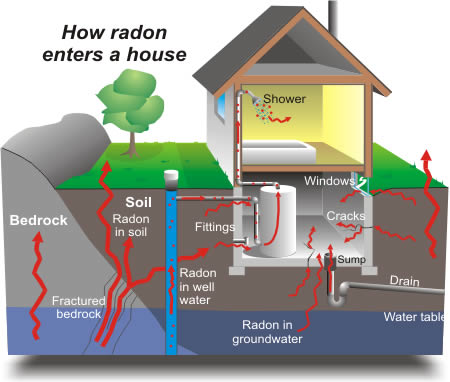|
Maryland has a new Radon testing law made effective on October 1, 2016.
This new law applies to Montgomery County homes that are being sold. The law requires that the radon test results are less than 1 year old prior to settlement, during real estate transactions and radon contingency on a sales contract.
With this in mind, Maryland Radon Testing offers fast and accurate Radon testing services in Maryland. Families can protect themselves and test their homes for radioactive radon. Radon contingency in real estate transactions was put in place to mitigate the hazardous health effects of the dangerous gas, especially in health zone 1 areas like Montgomery county Maryland.
Maryland Radon Testing Inspectors are certified in radon
gas Inspections and can help you to assure that your home is safe from this
dangerous, cancer causing gas.
"Conflict of
Interest"
"Radon Gas Testing and Radon Gas Mitigation (abatement)"
These two services are very different and need to be separate!!
A big conflict of interest does exist in the Radon Gas Testing and Radon Gas Mitigation (abatement) businesses.
As a consumer you really need to be aware of the potential conflict of interest that exists between these two separate businesses and don’t allow yourself to get ripped off. There are many companies that their main business is the Remediation of Radon Gas Testing and really are not interested in testing first to see if you really have Radon Gas and the extent of it. Their main objective is to get you to agree to a Mitigation (abatement) job which is typically very expensive and in many cases not even needed. Prior to any Mitigation or abatement services ever take place; a proper test needs to be performed by a qualified and Certified Indoor Air Consultant.
There are so many horror stories of consumers getting ripped off because they got talked into jumping right into an expensive Mitigation (abatement) system before having an unbiased Professional/certified Radon Gas Test performed by a relatively inexpensive actual Certified Radon Gas Tester. By doing this first you can potentially save yourself from falling prey to a scam and get taken for your hard earned money.
What is Radon Gas?
Radon is a colorless, odorless, tasteless, radioactive gas. It is not poisonous. Radon occurs naturally from the breakdown of deposits of radium and uranium that are present in virtually all soils everywhere in the US and throughout the world. Normally, the radon gas disperses harmlessly into the air; but, it can get into homes, and since you can't see it or smell it, you can't tell if it’s there.
Radon is a "noble" or "inert" gas, which means it doesn't combine readily with other elements. Radon is the heaviest known gas, 9 times denser than air, and it consists of one, tiny, single atom—so it can penetrate most common building materials like sheet rock, mortar, wood, most insulation, even concrete.
and block walls or flooring.
What is a radon test?
A radon test is a simple, non-invasive test that can be conducted in as little as 48
to 96 hours to determine if radon gas is present. The inspector will need access to the home to initially place the measurement
devices, and to retrieve the devices upon completion of the test. A
detailed analysis is performed by a certified lab and results are provided
to you generally within 2 days of submission for analysis. Not all inspectors are
equal or even certified to perform a radon measurement inspection.
Certification is not required in the state of Maryland, however, to set
us apart from others Maryland Home Inspection Services has chosen to be
100% certified and recognized by the International Association of Certified Indoor Air Consultants (IAC2). Certification # IAC2-02-0919.
All of our Radon Gas testing equipment and Laboratory Analysis comes
from the professional side of Radon.com
What can I do if radon is detected?
First and foremost, "Don't Panic". In most cases, radon is easily mitigated by a trained
professional licensed mitigation company. Once mitigation has been completed, we can conduct a
Post Mitigation radon Measurement Clearance Test. We act as an unbiased third party to ensure that your mitigation was successful.
U.S. Surgeon General Health Advisory
"Indoor radon gas is the second-leading cause of lung cancer in the United States and breathing it over prolonged periods can present a significant health risk to families all over the country. It's important to know that this threat is completely preventable. radon can be detected with a simple test and fixed through well-established venting techniques."
What you should know about radon?
Radon is a cancer-causing natural radioactive gas that you can’t see, smell or taste.
Radon comes from the natural breakdown of uranium in soil, rock and water. The release of this radioactive gas enters the air you breathe, causing a potential health risk to you and your family. radon gas can be found in just about anywhere. It can get into any type of building -- homes, offices, and schools -- and build up to high levels.
radon can also be present in your water, gas can dissolve and accumulate in underground water sources and permeate into your drinking water supply. A separate radon Water Test can be performed to ensure that your water is safe for consumption.
You should test for radon.
Testing is the only way to find out about your home's radon level. The EPA and the Surgeon General recommend testing of all homes below the third floor for radon.
Home Buyer's and Seller's Guide to Radon
Take a few minutes to learn all about radon. This may just be
some of the most important life saving information you will ever learn. Important
Radon Information.
You can fix a radon problem. If you find that you have high radon levels, there are ways to fix a radon problem. Even very high levels can be reduced to acceptable levels.
How Does Radon Enter a Home?
There are two main sources for the radon in your home's indoor air: the soil and the water supply. Compared to radon entering the home through water, radon entering your home through the soil is usually a much larger risk.

The cost of radon testing
Radon testing is about $185.00 depending on the size and configuration of the house
to be tested. Please ask us about our radon testing services and
give yourself peace of mind.
Maryland's radon Zone Map shows each
county's radon risk level. The red areas have the highest radon risk.
The big issue about radon is that it is a gas when we inhale it, but
if it decays into solids while it is in our lungs, those solids stay in
our lungs for the rest of the decay cycle, emitting alpha, beta and
gamma particles.

What do the colors mean?
|
|
Zone 1 counties
have a predicted average indoor radon screening level greater
than 4 pCi/L (picocuries per liter) (red zones) |
Highest Potential |
|
|
Zone 2 counties have a
predicted average indoor radon screening level between 2 and 4
pCi/L (orange zones) |
Moderate Potential |
|
|
Zone 3 counties have a
predicted average indoor radon screening level less than 2 pCi/L
(yellow zones) |
Low Potential |
|